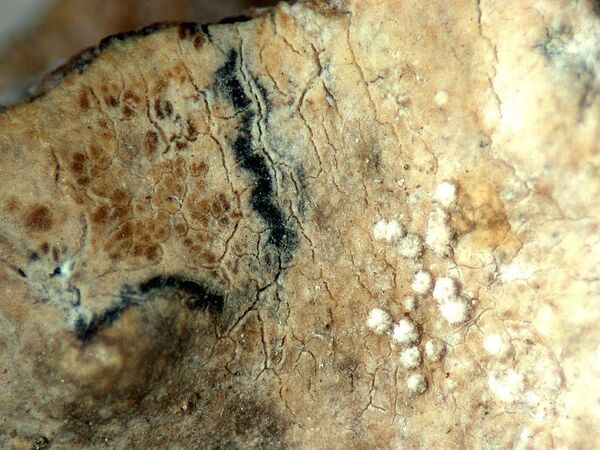Syncesia myrticola (Fée) Tehler sterile morph
Fl. Neotrop. Monogr., 75: 18, 1997. Basionym: Chiodecton myrticola Fée - Essai Cryptog. Ecorc. Offic., 1: 63, 1824.
Synonyms: Enterographa sorediata Coppins & P.James
Distribution:
Description: Thallus crustose, episubstratic, continuous and smooth to folded-nodulose, chalky white to pale grey, water-repellent, sorediate, often delimited by a dark, fimbriate prothallus. Soralia white-grey, concolorous with or paler than thallus, orbicular and discrete, to 0.5 mm in diam., sometimes arranged in lines along the margins of cracks bordering the areoles, or becoming confluent into larger, erose sorediate patches, the soredia farinose, with packed, highly refractive crystals. Apothecia and pycnidia usually absent. Photobiont trentepohlioid. Spot tests: thallus K-, C-, KC-, P+ rust-red, UV+ cream-coloured, K/UV+ bright blue. Chemistry: protocetraric and roccellic acids.Note: sorediate morphs of Syncesia myrticola were previously treated as Enterographa sorediata. They grow on rain-sheltered surfaces of the trunks of old deciduous trees in old, open woodlands, and were never recorded from Italy. They should be looked for in the Tyrrhenian ecoregion.
Growth form: Crustose
Substrata: bark
Photobiont: Trentepohlia
Reproductive strategy: mainly asexual, by soredia, or soredia-like structures (e.g. blastidia)
Most common in areas with a humid-warm climate (e.g. most of Tyrrenian Italy)
In underhangs rarely wetted by rain

Predictive model
Growth form: Crustose
Substrata: bark
Photobiont: Trentepohlia
Reproductive strategy: mainly asexual, by soredia, or soredia-like structures (e.g. blastidia)
Most common in areas with a humid-warm climate (e.g. most of Tyrrenian Italy)
In underhangs rarely wetted by rain

Predictive model


